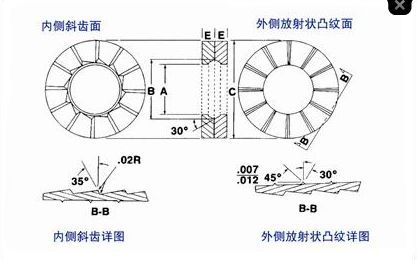
lock washer
Various machines and components are inseparable from fasteners in connection assembly. Fasteners bring convenience to the machinery industry, but they also have an inevitable weakness, that is, they will loosen by themselves in severe vibration, causing damage, disintegration or even accidents to parts or a complete equipment.
The anti-loosening washer can prevent the thread from loosening. There are many types of lock washers, including butterfly washers, saddle washers, spring washers, wave spring washers, etc., commonly known as lock washers.

The anti-loosening washers of the above types all rely on increasing the static friction to achieve the anti-loosening effect. The anti-loosening effect under low vibration, light load and constant speed can meet the needs of enterprises. However, in the case of strong vibration, high load, and fast movement, it cannot achieve the effect of complete anti-loosening, and can only prolong the time for the nuts and bolts to loosen by themselves.
In order to solve this problem, scientists around the world have done a lot of experiments and research, and finally broke through the common crime, breaking the previous method of using increased “preload” and “friction force” to achieve the anti-loosening effect, and changed it to The latest anti-loosening principle that combines “lifting tension” and “friction force” with “geometric wedge angle”, this principle is not only used in washers, but also in nuts and bolts, thus solving the problem of heavy industry enterprise fasteners The problem of looseness also solves the cumbersome installation without referring to the screw-in torque and screw-out torque.

Most effective lock washers.
It consists of two washers. The outer surface is a radial convex surface, and the inner surface is a helical tooth surface. When assembling, the inner helical tooth surfaces are opposite, and the outer radial convex surface and the contact surfaces at both ends are in a state of occlusion. When the connecting piece is subjected to vibration and the bolt tends to loosen, only the inner helical tooth surfaces of the two washers are allowed to face each other. Misalignment generates lifting tension, thus achieving 100% locking effect. Its anti-loosening principle complies with military standards. (MIL-STD-1312 standard by the U.S. military) Lock washers are both an anti-loose locking device and a high-load locking device that can be used in all high-vibration environments. If lock washers are used and installed correctly, the nuts and bolts do not need to be retightened, keeping the fastener secure.
Installation and working principle of lock washer.
1. The installation of the anti-loosening washer is very simple, only need to place the helical tooth surface oppositely in the two washers, and place it between the nut and the connecting material.
2. After the nut is tightened, the outer radial embossed surface of the anti-loosening washer meshes with the contact surfaces at both ends, and the inclination angle of the inner helical tooth surface of the washer is greater than the thread angle of the bolt.
3. When the bolt is elongated due to mechanical vibration, the nut will rotate and loosen accordingly. However, the friction force of the outer radial convex surface of the lock washer is greater than the friction force between the inner helical tooth surfaces, so in this state, only the relative displacement between the inner helical tooth surfaces is allowed to generate lifting tension. Shrink the bolt by lengthening it.
4. When the bolt shrinks, the helical tooth surface of the washer will return the nut to its original position.
5. Lock washers are only suitable for use on flat and relatively smooth metal surfaces.
6. If the joining material is non-metallic, a metal plate can be fixed to the joining material so that a lock washer can be used.
7. A torque wrench is not required to install the lock washer.
8. Air tools are also optional when installing or removing lock washers.
Post time: Jan-13-2023
